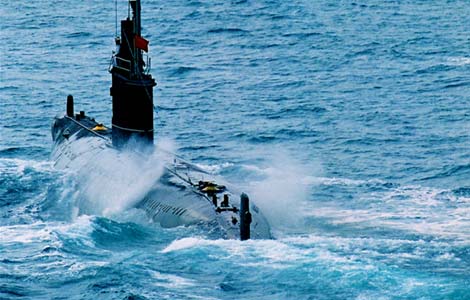The wonderful world of wax
Updated: 2013-10-25 09:59
By Cecily Liu (China Daily Europe)
|
|||||||||||
China's affluent middle class are flocking to smaller amusement venues, such as Madame Tussauds
British amusement venue operator Merlin Entertainments Group is strengthening its foothold in the Chinese market, with the opening of a new Madame Tussauds in Wuhan this October.
There are more than 50 lifelike wax figures, including Chinese tennis player Li Na, actor Jackie Chan and singer Jay Chou. The wax museum is in Han Street, which runs along the south bank of the Chu River, and is part of Wuhan's central cultural zone.
Glenn Earlam, Merlin Entertainments' managing director of midway attractions, says China will be the group's number one growth market in the next few years. Midway attractions are indoor entertainment venues that can be seen in a few hours.
Earlam says visitor numbers at Madame Tussauds Hong Kong have grown sevenfold since it opened in 2000. Visitor number at the Shanghai museum, which opened in 2006, have trebled since then.
Founded in the United Kingdom in 1998, Merlin Entertainments is now the world's second-largest amusement venue operator after Walt Disney Parks and Resorts.
In China, aside from operating the three Madame Tussauds, Merlin Entertainments also operates Ocean World aquarium in Shanghai, which became a part of its group as a consequence of acquiring Living and Leisure Australia Group in 2011.
Earlam says the company also has plans to open a cluster of three attractions in Chongqing from 2015: a Madame Tussauds, a Sea Life aquarium and a Legoland Discovery Center.
More than 6 million overseas tourists and many more domestic ones have visited Changfeng Ocean World in Shanghai. It offers performances by polar beluga whales, California sea lions, dolphins and other marine mammals.
Located 13 meters under the man-made Yinchu Lake, the aquarium has 300 fish species on display. It is divided into different sections that represent different animal habitats: Jungle Explore, Coral Reef Cluster, Deep Sea Wreck, Shark Corridor and Penguin Pavilion.
The aquarium is used by diving clubs and an "undersea wedding" service, and also offers overnight camps.
At Hong Kong Madame Tussauds, apart from international figures, many local stars from Hong Kong's film and music industries are showcased, such as actors Jackie Chan and Bruce Lee.
The Shanghai Madame Tussauds features many more Chinese stars, like the former basketballer Yao Ming, film directors Feng Xiaogang and Zhang Yimou, and actress Fan Bing Bing.
Earlam says that localization of entertainment venues is a key strategy of Merlin Entertainments' China expansion. "While our attractions are all based on the same proven global concepts, each one is tailored to ensure it is also very Chinese in its nature and appeal."
This is especially true of Madame Tussauds, he says, where each attraction is "the face of the place" with at least one-third of the figures chosen representing local Chinese celebrities, another third representing celebrities from the rest of Asia, and the rest international.
To achieve this, his team does a lot of local research to ensure the end products reflect the interests and culture of the local people, Earlam says.
As a demonstration of this localization strategy, Li Na, who was born in Wuhan, attended the launch of Madame Tussauds in that city. She posed in front of her wax figure so people could see the close likeness of the wax model.
Earlam says the launch was a great success locally, particularly because Li's dynamic tennis pose made her and her wax figure fun to see.
The Madame Tussauds wax figures are all made at the company's studio in London. Typically, it takes more than 20 artists more than 800 hours to create each figure.
Earlam says the figures are often moved between different locations, so people visiting the same Madame Tussauds at different times can enjoy different wax figures.
He says one difference he noticed with the profile of Chinese customers is that they are typically women in their 20s, instead of the women in their 30s who account for most of Madame Tussauds' customer base in Western markets.
One reason for this, he says, could be that visitors to Madame Tussauds in the West are usually overseas tourists, and slightly older people can more easily afford such trips. Perhaps visitors to the Madame Tussauds in China are tourists from other Chinese cities on shorter visits, which younger customers can afford, Earlam says.
Another difference is that Chinese visitors have a greater interest in posing for photos next to wax figures. To facilitate this experience, his team has worked hard to provide costumes and accessories next to the wax figures for customers to pose in.
"For example, if we have a wax figure in a white jacket, we would have a white jacket next to the figure, so our visitors can put on the same sort of jacket for photos," he says.
But Earlam admits that one feature which perhaps did not work so well was putting too much technology into the experience when setting up Madame Tussauds in Shanghai.
"We had a touch screen for visitors to play music that was associated with the wax figures, but that wasn't so popular. So in the end we realized maybe our visitors would prefer simpler experiences, like putting a hat on."
Looking at the next few years, Earlam says the rate at which Merlin Entertainments will open new attractions in China will be faster than in any other market.
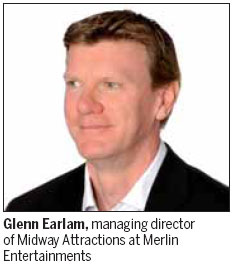
"We hope to expand through a cluster model, where the same management team can look after several different attractions in the same city, and each attraction can promote the other," Earlam says.
One challenge is to look for good locations in China, and his team is working with Chinese developers and landlords to make sure Merlin Entertainments' attractions are included in their thinking when planning new developments.
The company's partner developers and landlords include Dalian Wanda Group in Wuhan, and Hongkong Land Holdings and China Merchants Property Development in Chongqing.
According to Earlam, China's entertainment industry has grown particularly rapidly since 2007, supported by the increasing number of affluent urban dwellers on the lookout for new leisure experiences.
One of the most talked about amusement attractions in China is the Disneyland set to open in Shanghai in 2015, which will be China's second Disneyland after the one in Hong Kong, which opened in 2005.
Shanghai Disneyland will cover 3.9 square kilometers, making it three times larger than Hong Kong Disneyland. At the heart of the Shanghai venue will stand Enchanted Storybook Castle, which will be the world's tallest and largest Disney castle.
There are also many domestic players in the amusement park market. The biggest is OCT Group, which opened its first theme park in the country, Splendid China, more than 20 years ago. Its best-known brand is Happy Valley. Other operators include Ocean Park in Hong Kong, the Shenzhen Huaqiang Group and the Haichang Group of Dalian.
Earlam believes midway attractions have greater potential for growth in China, as the theme park market started earlier and is now more mature with less room for expansion.
"China offers great potential for our business," he says. "More than that, it is a very exciting and dynamic market, and the feedback we have had both from our existing attractions and from the research we have done across China, shows that Chinese tourists love our brands, and really appreciate the quality of what is on offer.
"The combination of urbanization and the phenomenal and consistent economic growth in China has resulted in a very fast emerging middle class looking for new quality experiences and ways in which to enjoy their growing wealth."
cecily.liu@chinadaily.com.cn
|
Li Na with her wax figure at the opening ceremony of Madame Tussauds in Wuhan. Provided to China Daily |
(China Daily European Weekly 10/25/2013 page21)
Today's Top News
Mythbuster dispels fictions about China
Forum urges stableChina-Japan ties
NSA spying hurts US diplomacy
Carrier rocket sent to launch base for moon landing
Requirements cut for business startups
Study shows PM1 most harmful
Cold snap to sweep NE, N China
Paper apologizes for reporter's untrue stories
Hot Topics
Lunar probe , China growth forecasts, Emission rules get tougher, China seen through 'colored lens', International board,
Editor's Picks

|
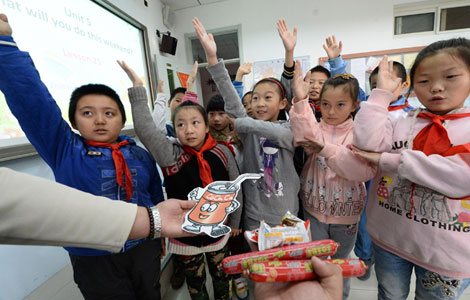
|
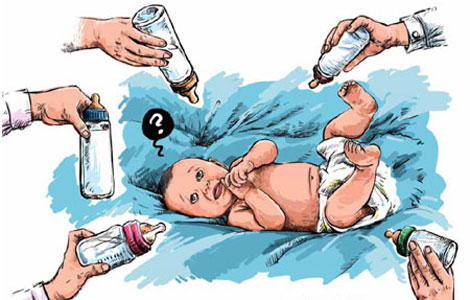
|

|
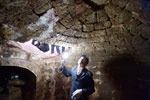
|
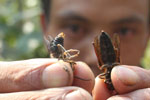
|



